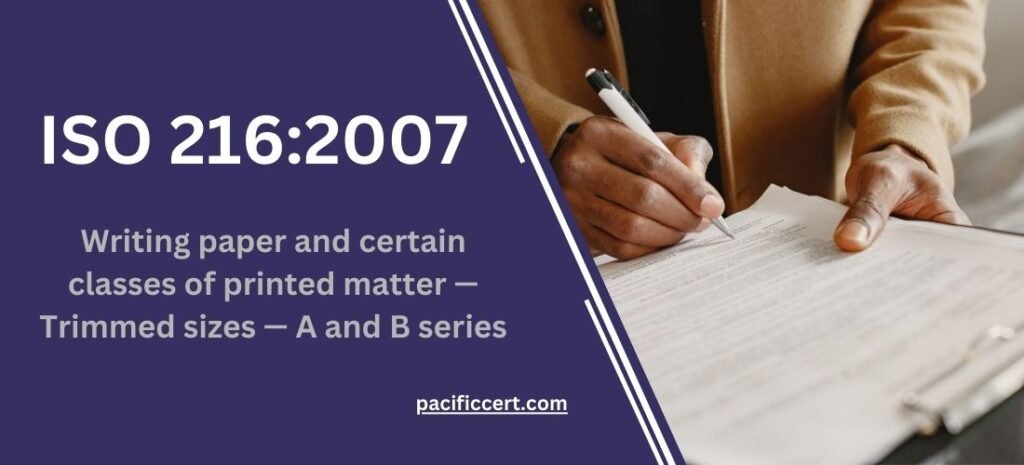
What is ISO 216:2007 Writing paper and certain classes of printed matter-Trimmed sizes -A and B series, and indication of machine direction?
ISO 216:2007 Writing paper and certain classes of printed matter is an international standard that specifies the dimensions of a series of paper sizes, commonly referred to as the A and B series. This standard is widely adopted around the world, except in countries like the United States, Canada, and Mexico, which use different systems like the “Letter,” “Legal,” and “Tabloid” paper sizes. The ISO 216 standard aims to standardize paper sizes to facilitate compatibility and interoperability across different applications, printers, and countries.
A and B Series
The A series is the most commonly used and starts with the A0 size, which has an area of 1 square meter. Each subsequent size in the A series (A1, A2, A3, etc.) is defined by halving the preceding paper size along its larger dimension. This results in a set of paper sizes that are all proportionally related, making it easier to scale documents without distortion.
Furthermore, the B series is less commonly used and serves as a supplementary series to the A series. The dimensions of the B series are geometric means between the A series sizes. For example, B1 dimensions are the geometric mean between A0 and A1.
Indication of Machine Direction
The standard also specifies the indication of machine direction, which is the direction in which the paper moves through the machine during its manufacturing process. This is important for certain printing and binding applications where the paper’s grain direction can affect the quality and durability of the final product.
Importance and Applications
The standardization of paper sizes has several benefits:
- Efficiency: Standard sizes make it easier for manufacturers to produce paper and for consumers to buy it. This reduces waste and increases efficiency in production and usage.
- Interoperability: A standardized paper size ensures that documents can be easily printed, copied, or scanned on equipment manufactured by different companies or located in different countries.
- Design and Layout: Designers and publishers benefit from a standardized system as it simplifies the design process, making it easier to create layouts that can be easily resized.
- Global Business: For organizations like Pacific Certifications, which deal with international standards such as ISO 9001 or ISO 14001, understanding and adhering to ISO 216 can be beneficial when dealing with international clients or suppliers. It ensures that documentation, reports, and other paper-based communications are compatible across borders.
In summary, ISO 216:2007 plays a crucial role in standardizing paper sizes, thereby facilitating various applications in printing, publishing, and document storage. It contributes to efficiency, interoperability, and standardization, which are key factors in both domestic and international business operations.
What are the requirements for ISO 216:2007?
ISO 216:2007 Writing paper and certain classes of printed matter standard outlines specific requirements for the dimensions of writing paper and certain classes of printed matter. These requirements are designed to ensure uniformity and compatibility across different applications and geographical locations. Below are some of the key requirements:
Dimensions of A and B Series Paper Sizes
- A Series: The standard starts with the A0 paper size, which has an area of 1 square meter and dimensions of 841 x 1189 mm. Each subsequent size in the A series is obtained by halving the preceding paper size along its larger dimension. For example, A1 is 594 x 841 mm, A2 is 420 x 594 mm, and so on.
- B Series: The B series paper sizes are defined as geometric means between the dimensions of the A series sizes. For instance, B1 dimensions are the geometric mean between A0 and A1, B2 dimensions are the geometric mean between A1 and A2, and so forth.
Tolerances
The standard specifies tolerances for each paper size. These tolerances are generally ±1.5 mm for dimensions up to 150 mm, ±2.0 mm for dimensions in the range of 150 mm to 600 mm, and ±3.0 mm for dimensions above 600 mm.
Indication of Machine Direction
The standard also outlines the requirement for indicating the machine direction, which is the direction in which the paper moves through the machine during its manufacturing process. This is particularly important for certain printing and binding applications.
Marking and Labeling
The paper should be marked or labeled to indicate its size and series (A or B), and often its grammage (weight per unit area), especially if it is intended for special printing tasks.
Quality Requirements
While ISO 216:2007 primarily focuses on dimensions, it is often used in conjunction with other ISO standards that specify quality requirements for paper, such as ISO 536 for paper and board grammage, or ISO 2471 for paper and board opacity.
Applications
The standard specifies that it is applicable to writing paper, drawing paper, and certain classes of printed matter. It is not intended to apply to all types of paper, such as newsprint or specialized industrial papers.
Importance for Certification Bodies
For certification bodies like Pacific Certifications, understanding the requirements of ISO 216:2007 can be crucial when auditing or certifying organizations that deal with document management systems (like ISO 27001 for Information Security Management) or quality management systems (like ISO 9001). Ensuring that an organization adheres to international standards for paper sizes can be a part of ensuring overall compliance with best practices and international norms.
In summary, ISO 216:2007 sets forth a comprehensive set of requirements aimed at standardizing paper sizes. Adherence to these requirements ensures compatibility and interoperability, which are essential for both domestic and international business operations.
What are the benefits of ISO 216:2007 Writing paper and certain classes of printed matter?
The adoption of ISO 216:2007 for writing paper and certain classes of printed matter offers several benefits, both at the organizational and global levels. Here are some of the key advantages:
Standardization and Uniformity
- Ease of Scaling: The proportional relationship between different sizes in the A and B series allows for easy scaling of documents without distortion. This is particularly beneficial in design and publishing industries.
- Interchangeability: Standard sizes mean that paper products and printing devices can be designed to a common specification, making it easier to interchange them without issue. This is crucial for businesses operating in multiple countries.
Efficiency and Cost-Effectiveness
- Reduced Waste: Standardized paper sizes make it easier to calculate the amount of paper needed for a particular job, reducing waste. This is not only cost-effective but also environmentally friendly, aligning with environmental management systems like ISO 14001.
- Economies of Scale: Manufacturers can produce paper more efficiently when they adhere to a standard set of sizes. This can lead to reduced costs for both manufacturers and consumers.
Quality and Performance
- Improved Print Quality: Knowing the machine direction of the paper, as indicated by the standard, can affect the quality of the print job, especially for high-quality printing where the grain direction is important.
- Durability: In binding and other paper-crafting applications, the machine direction can affect the paper’s strength and durability, which is crucial for long-lasting printed materials.
Global Business and Trade
- International Compatibility: For international businesses and certification bodies like Pacific Certifications, adhering to a globally recognized standard like ISO 216:2007 simplifies transactions and documentation processes across borders.
- Regulatory Compliance: In some industries and countries, compliance with ISO standards is a regulatory requirement. Being in compliance can make it easier to pass audits and meet other regulatory criteria.
Technological Integration
- Digital-to-Print Consistency: In the age of digital documentation, having a standardized paper size helps in maintaining consistency when documents are transferred from digital to print formats.
- Equipment Compatibility: Standard paper sizes mean that printers, copiers, and scanners can be designed to accommodate these sizes, making it easier for consumers to purchase compatible equipment.
Evidence and Examples
- Case of the European Union: The EU mandates the use of ISO paper sizes, which has facilitated easier business transactions and documentation processes among member countries.
- Environmental Impact: Companies adhering to ISO 14001 for environmental management often find it easier to also comply with ISO 216, as both can contribute to waste reduction.
- Global Companies: Multinational corporations like IBM or Toyota, which operate in multiple countries, benefit from standardized paper sizes for internal documentation, thereby reducing complexity and increasing efficiency.
In summary, the benefits of ISO 216:2007 are manifold, ranging from operational efficiencies and cost savings to global standardization and regulatory compliance. These advantages make it a valuable standard for a wide range of stakeholders, including manufacturers, businesses, and certification bodies.
Who needs ISO 216:2007 Writing paper and certain classes of printed matter?
The ISO 216:2007 standard for writing paper and certain classes of printed matter is relevant to a wide range of stakeholders, each with specific needs that the standard addresses. Here’s a breakdown:
Manufacturers and Suppliers
- Paper Manufacturers: They need to adhere to these standards to ensure their products are compatible with printing and copying equipment, as well as to meet international trade requirements.
- Printing Equipment Manufacturers: Companies that produce printers, copiers, and scanners design their products to accommodate standardized paper sizes, ensuring compatibility and reducing the risk of paper jams or other issues.
End Users
- General Consumers: For everyday tasks like printing, copying, and scanning, using standardized paper sizes simplifies these processes.
- Businesses and Corporations: Standardized paper sizes are crucial for internal and external documentation, especially for companies that operate internationally.
- Educational Institutions: Schools, colleges, and universities benefit from standardized paper sizes for academic materials, examinations, and publications.
- Government Agencies: Standardized documentation is critical for regulatory compliance, record-keeping, and public communications.
- Designers and Publishers: Graphic designers, publishers, and artists often require standardized paper sizes for layout design, printing, and scaling.
Certification and Regulatory Bodies
- Certification Bodies: Organizations like Pacific Certifications may need to understand ISO 216:2007 when auditing or certifying other standards that involve documentation, such as ISO 9001 for Quality Management Systems or ISO 27001 for Information Security Management.
- Regulatory Agencies: In some jurisdictions, adherence to ISO standards like ISO 216:2007 may be a legal requirement, making it essential for regulatory bodies to enforce these standards.
Specialized Industries
- Healthcare Providers: Medical records, prescriptions, and other healthcare-related documents often need to be standardized for easy storage and retrieval.
- Legal Firms: Legal documents often require standardized sizes for filing and archiving purposes.
- Architects and Engineers: Technical drawings and plans often use standardized paper sizes for easy scaling and reproduction.
Evidence and Examples
- European Union: The EU mandates the use of ISO paper sizes, making it essential for any business or institution operating within the EU to adhere to ISO 216:2007.
- Global Corporations: Companies like Apple or Microsoft that operate in multiple countries use standardized paper sizes for their internal and external documentation, thereby streamlining operations.
- Certification Requirements: For organizations seeking ISO 9001 certification, adherence to all relevant ISO standards, including ISO 216:2007 for paper sizes, can be a part of the certification process.
In summary, ISO 216:2007 is not just for a specific sector but has broad applicability across various industries and user groups. Its adoption facilitates standardization, efficiency, and compatibility, making it a valuable guideline for multiple stakeholders.
At last, Pacific Certifications is accredited by ABIS, you need more support with ISO 216:2007 Writing paper and certain classes of printed matter, please contact us at +91-8595603096 or support@pacificcert.com
Also Read About: ISO 2493 Paper and board







